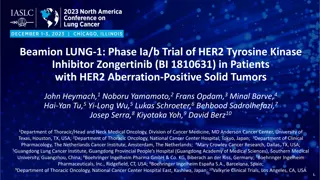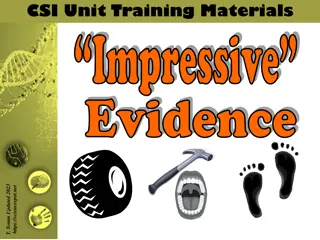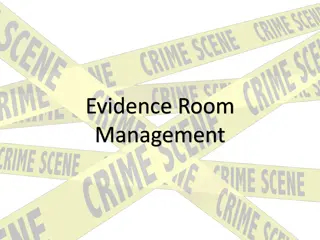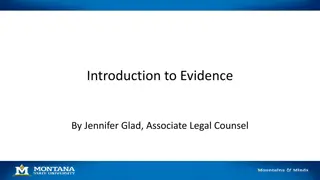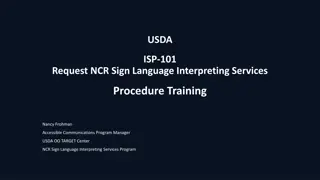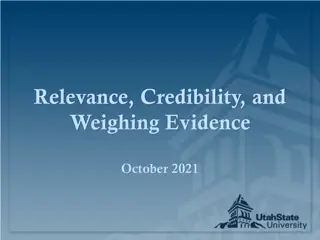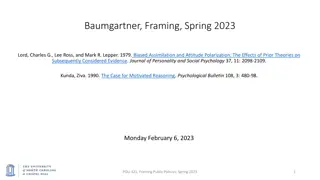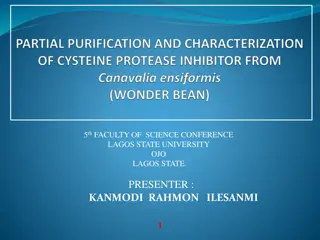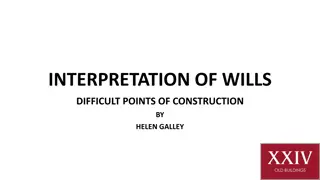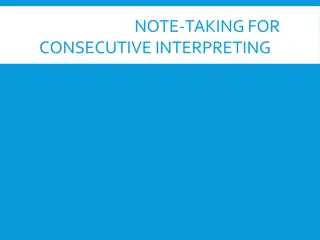Interpreting Evidence on Inhibitor Development in PUPs According to FVIII Concentrate
Alfonso Iorio from McMaster University discusses the methodology for assessing causality, analyzing data on the risk of inhibitors with FVIII concentrate, and the implications for patients. The presentation covers various aspects such as multivariable analysis, brand comparisons, gene mutations, and family history in hemophilia treatment.
Download Presentation

Please find below an Image/Link to download the presentation.
The content on the website is provided AS IS for your information and personal use only. It may not be sold, licensed, or shared on other websites without obtaining consent from the author.If you encounter any issues during the download, it is possible that the publisher has removed the file from their server.
You are allowed to download the files provided on this website for personal or commercial use, subject to the condition that they are used lawfully. All files are the property of their respective owners.
The content on the website is provided AS IS for your information and personal use only. It may not be sold, licensed, or shared on other websites without obtaining consent from the author.
E N D
Presentation Transcript
Inhibitor development according to FVIII concentrate in PUPs: how to interpret current evidence? Alfonso Iorio Health Information Research Unit & Hamilton-Niagara Hemophilia Program McMaster University
Disclosures for Alfonso Iorio In compliance with COI policy, EAHAD requires the following disclosures to the session audience: Shareholder No relevant conflicts of interest to declare Grant / Research Support Bayer, Baxter, Biogen Idec, Novo Nordisk, Pfizer Consultant Bayer, Baxter, Novo Nordisk Employee No relevant conflicts of interest to declare Paid Instructor No relevant conflicts of interest to declare Speaker bureau No relevant conflicts of interest to declare Honoraria Bayer, Baxter, CSL, Octapharma, Pfizer Presentation includes discussion of the following off-label use of a drug or medical device: <N/A>
Overview 1) Assessing causality: methodological notes 2) Appraising data on the concentrate dependent risk of inhibitors 3) Implications and perspectives
Overview 1) Assessing causality: methodological notes 2) Appraising data on the concentrate dependent risk of inhibitors 3) Implications and perspectives
KOGENATE ADVATE
RANDOM NEXT PATIENT MULTIVARIABLE ANALYSIS Large deletion + history history mutation history mutation history mutation history history + history Deletion Point + Point Family Point Family Point Point + Family Deletion
MULTIVARIABLE ANALYSIS Brand Gene mutation Family history
MULTIVARIABLE ANALYSIS Brand Gene mutation Family history ? ??Unknow n ??
MULTIVARIABLE ANALYSIS Brand Gene mutation Kogenate/ Advate Family history ? ??Unknow n ??
Assessing causality summary notes Selection by indication Selection by indication Unbalanced risk of event at baseline Center effect The effect of center is a proxy for what you cannot measure it is constantly checked even in randomized trials Methods exists for small centers Center effect and center size effect ARE NOT the same McGilchrist, CA et al. Regression with frailty in survival analysis. Biometrics, 1991 47, 461-6. Hougaard, P. Frailty models for survival data. Lifetime Data Analysis, 1995, 1, 255-273.
Overview 1) Assessing causality: methodological notes 2) Appraising data on the concentrate dependent risk of inhibitors 3) Implications and perspectives
Concentrate based risk of inhibitors RODIN France Coag UK UKHCDO Vazina EUHASS EAHAD Metanalysis For each one: Design Main result Key to appraisal Does it point to a true difference of K vs A as the most likely explanation?
Evidence profiling Study Design Main result interpretation Contribution RODIN UKHCDO France C Vezina EUHASS EAHAD IPD
Evidence profiling Study Design Main result interpretation Contribution RODIN P, R, IC, MC Year: 2000-2010 Tot: 340 (574) RC, RD: 28.2, 9.0% Post hoc Multivariable (+) Hypothesis generation UKHCDO France C Vezina EUHASS EAHAD IPD P = prospective; R = retrospective; IC Inception cohort; MC = Multisite
Evidence profiling Study Design Main result interpretation Contribution RODIN P, R, MC Year: 2000-2010 Tot: 340 (574) RC, RD: 28.2, 9.0% Post hoc Multivariable (+) Hypothesis generation UKHCDO R, IC, SC Year: 2000-2010 Tot: 300 (407) RC, RD: 23.8, 11.3% Time effect, B-DD f-VIII, RODIN effect Generate alternative hypothesis France C Vezina EUHASS EAHAD IPD P = prospective; R = retrospective; IC Inception cohort; MC = Multisite, SC = single country
UKHCDO cohort: effect of time and RODIN? Kogenate Advate 83.3 Dashed line = RODIN centers 44.0 40.0 40.0 38.5 36.4 26.7 20.0 23.0 20.0 14.8 14.3 Y 2000-2004 Y 2005-2008 Y 2009-2013 Advate 3/12 Kogenate 24/65 26/117 16/31 13/43 5/32
Evidence profiling Study Design Main result interpretation Contribution RODIN P, R, IC, MC Year: 2000-2010 Tot: 340 (574) RC, RD: 28.2, 9.0% Post hoc Multivariable (+) Hypothesis generation UKHCDO R, IC, SC Year: 2000-2010 Tot: 300 (407) RC, RD: 23.8, 11.3% Time effect, Refacto, RODIN effect Generate alternative hypothesis France Coag R, IC, SC Year: 2000-2010 Tot: 234 (303) RC, RD: 30.0, 15.0% center effect Multivariable (-) RODIN effect ?? Generate a second alternative hypothesis Vezina EUHASS EAHAD IPD P = prospective; R = registry; MC = multiple centers/countries, IC = inception cohort, SC = single country
? N? ? ? Product? D? (Kogenate)? PUPs? (n)? (n)? Product? E? (Advate)? Product? D? ? Product? E? (%)?PUPs? Inhibitors? Inhibitors? (n)? (%)? AD? (%)? 95%? CI? Centers? (n)? All? centers? 234? 124? 56? 45? 110? 33? 30? 15? 3? 27? Centers? 1,3,13(#)? All? but? 1,3,13? ?Kreuz W, Gill JC, Rothchild C et al. Thrombosis and Haemostasis 2005; 93:457-467 15% inhibitor rate with Kogenate (1997-2001) 73? 50? 29? 58? 23? 4? 17? 41? 17? 47? 171? 74? 27? 36? 87? 29? 33? 3? -11? 18?
Evidence profiling Study Design Main result interpretation Contribution RODIN P, R, IC, MC Year: 2000-2010 Tot: 340 (574) RC, RD: 28.2, 9.0% Post hoc Hypothesis generation UKHCDO R, IC, SC Year: 2000-2010 Tot: 300 (407) RC, RD: 23.8, 11.3% Time effect, B-DD f-VIII, RODIN effect Generate alternative hypothesis France C R, IC, SC Year: 2000-2010 Tot: 234 (303) RC, RD: 30.0, 15.0% Strong center effect RODIN effect ?? Generate a second alternative hypothesis Vezina S, SC Y:2005-2010 Tot:86 (99) RC, RD: 36.0, 6.0% Higher rate with Advate You cannot export results? EUHASS EAHAD IPD P = prospective; R = registry; MC = multiple centers/countries, IC = inception cohort, SC = single country; S = survey
Evidence profiling Study Design Main result interpretation Contribution RODIN P, R, IC, MC Year: 2000-2010 Tot: 340 (574) RC, RD: 28.2, 9.0% Post hoc Hypothesis generation UKHCDO R, IC, SC Year: 2000-2010 Tot: 300 (407) RC, RD: 23.8, 11.3% Time effect, B-DD f-VIII, RODIN effect Generate alternative hypothesis France C R, IC, SC Year: 2000-2010 Tot: 234 (303) RC, RD: 30.0, 15.0% Strong center effect RODIN effect ?? Generate a second alternative hypothesis Vezina S, SC Y:2005-2010 Tot:86 (99) RC, RD: 36.0, 6.0% Higher rate with Advate You cannot export results? EUHASS P, DC, MC Y: 2009-2013 Tot: 284 (417) RC, RD: 26.2, 4.5% RODIN effect Non-confirmatory EAHAD IPD P = prospective; R = registry; MC = multiple centers/countries, IC = inception cohort, SC = single country; S = survey; DC = dynamic cohort;
EUHASS - RODIN EUHASS P 95% CI P 95% CI Plasma D 0.22 0.11 0.35 0.21 0.10 0.37 Recomb 0.26 0.22 0.31 0.24 0.19 0.29 Advate 0.26 0.19 0.34 0.26 0.18 0.36 Helixate 0.32 0.18 0.50 0.33 0.18 0.52 Kogenate 0.30 0.22 0.40 0.22 0.13 0.34 Refacto 0.29 0.17 0.43 0.27 0.15 0.43
Evidence profiling Study Design Main result interpretation Contribution RODIN P, R, IC, MC Year: 2000-2010 Tot: 340 (574) RC, RD: 28.2, 9.0% Post hoc Hypothesis generation UKHCDO R, IC, SC Year: 2000-2010 Tot: 300 (407) RC, RD: 23.8, 11.3% Time effect, B-DD f-VIII, RODIN effect Generate alternative hypothesis France C R, IC, SC Year: 2000-2010 Tot: 234 (303) RC, RD: 30.0, 15.0% Strong center effect RODIN effect ?? Generate a second alternative hypothesis Vezina S, SC Y:2005-2010 Tot:86 (99) RC, RD: 36.0, 6.0% Higher rate with Advate You cannot export results? EUHASS P, DC, MC Y:2009-2013 Tot:284 (417) RC, RD: 26.2, 4.5% RODIN effect Non-confirmatory EAHAD IPD MA, MC Y: 1994-2003 Tot: 80 (761) RC, RD: 40, 6.6% Any of the previous Non confirmatory Direction of effect Inconsistency P = prospective; R = registry; MC = multiple centers/countries, IC = inception cohort, SC = single country; S = survey; DC = dynamic cohort; MA = meta-analysis
Appraisal: final notes Discordant evidence Substantial unexplained variability UK: From different designs Meta-analysis Dynamic cohort by year, RODIN participation France-Coag: by center effect From different populations ??? PTP EUHASS, Xi RODIN: details unreported !!!!
Overview 1) Assessing causality: methodological notes 2) Appraising data on the concentrate dependent risk of inhibitors 3) Implications and perspectives
Randomized controlled trial Objective: ruling out OR 1.6 Sample size requirements
Implications If we trust RODIN & Co, we would have to: Consider extensive testing in at least 150 PUPs for 50 ED before feeling safe Consider implications for PTPs
EUHASS PTPs Advate 0.11 (0.03 0.25) Kogenate 0.17 (0.06 - 0.37) OR = 1.54 (0.24 12) Xi, PTP meta-analysis Kogenate Advate 0.10 (0.05 0.18) Kogenate 0.26 (0.16 - 0.44) Kogenate 0.11 (0.05 - 0.23) Advate OR = 2.6 (0.88 8.8) Aledort BDD meta-analysis Kogenate vs Advate High titer HR = 1.75 (0.05 65.5) All inhibitors HR, 2.43 (0.31 19.2)
Conclusion Is the RODIN & Co party over? The is no free lunch at the risk of inhibitor study club Either we accept to adopt better methods for prospective assessment, or we have to adapt to live with some uncertainty
Thank you !!! Download these slides at: Hemophilia.mcmaster.ca Join the WAPPS network at: www.wapps-hemo.org



